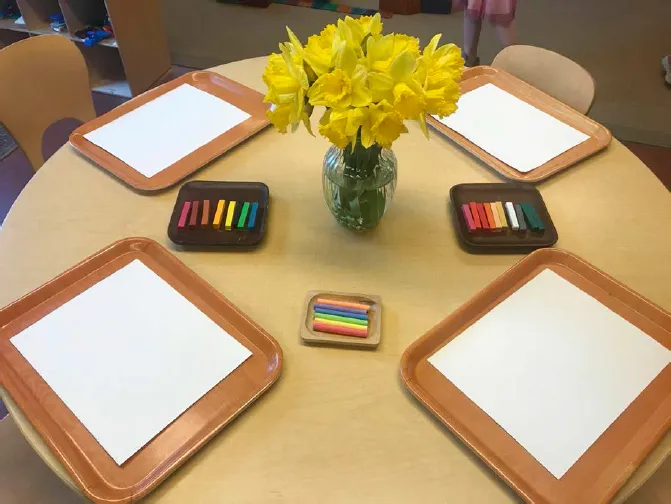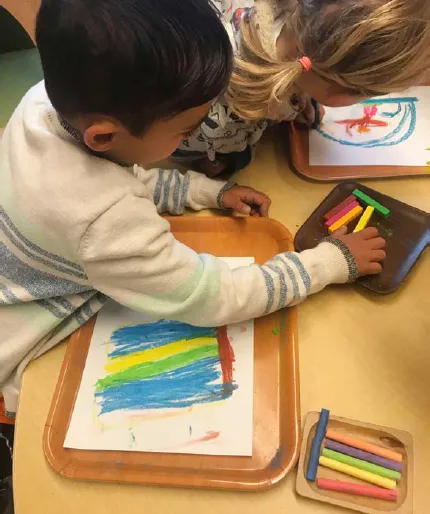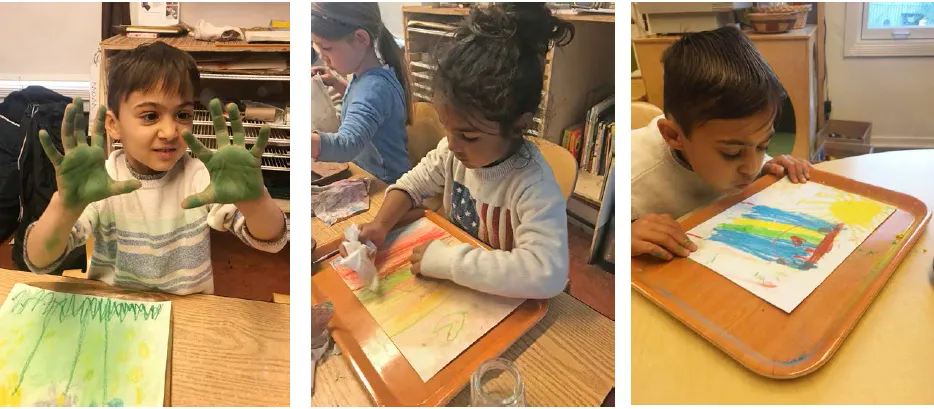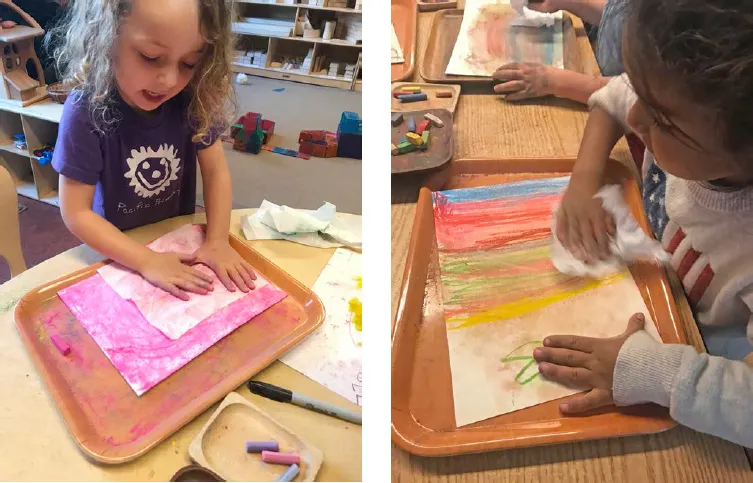
eBook - ePub
Children's Lively Minds
Schema Theory Made Visible
Deb Curtis, Nadia Jaboneta
This is a test
Buch teilen
- English
- ePUB (handyfreundlich)
- Über iOS und Android verfügbar
eBook - ePub
Children's Lively Minds
Schema Theory Made Visible
Deb Curtis, Nadia Jaboneta
Angaben zum Buch
Buchvorschau
Inhaltsverzeichnis
Quellenangaben
Über dieses Buch
- Deb Curtis is a well-known author and early childhood expert with an excellent sales record.
- Schema theory explains how we are able to digest information. Psychologist Jean Piaget described a schema as a thread of thought that is demonstrated by repeated actions and patterns. When children explore schemas by dropping a toy off their high chair repeatedly, they are building their understanding of abstract ideas, patterns, and concepts.
- Children engage in repetitive behavior such as building and knocking down block towers, dumping out toys, or mixing materials together, which can sometimes be irritating to adults. Children's Lively Minds looks at these actions through a schema lens to help teachers and parents understand what is really going on in the children's brain development when they engage in this repetitive behavior.
- This book is practical, user-friendly, and filled with stories about real children developing schema. Also included are reflection questions and advice for teachers on how to extend support for children's schema exploration and how to relate this information to families on what they might be seeing at home.
- Although it is helpful to read the book sequentially, readers can dip in and out of the narrative stories.
- This book can be used across all early childhood approaches—Reggio, Montessori, Waldorf, etc. Deb Curtis is very popular with Reggio Emilia practitioners.
- Schema theory is being used by early childhood educators and parents whether they know it or not. This book puts intention behind actions.
- Deb Curtis' most recent book, Really Seeing Children (published by Exchange Press; 2017), has struggled to stay in-stock. In the first year, they have had to reprint several times.
Häufig gestellte Fragen
Wie kann ich mein Abo kündigen?
Gehe einfach zum Kontobereich in den Einstellungen und klicke auf „Abo kündigen“ – ganz einfach. Nachdem du gekündigt hast, bleibt deine Mitgliedschaft für den verbleibenden Abozeitraum, den du bereits bezahlt hast, aktiv. Mehr Informationen hier.
(Wie) Kann ich Bücher herunterladen?
Derzeit stehen all unsere auf Mobilgeräte reagierenden ePub-Bücher zum Download über die App zur Verfügung. Die meisten unserer PDFs stehen ebenfalls zum Download bereit; wir arbeiten daran, auch die übrigen PDFs zum Download anzubieten, bei denen dies aktuell noch nicht möglich ist. Weitere Informationen hier.
Welcher Unterschied besteht bei den Preisen zwischen den Aboplänen?
Mit beiden Aboplänen erhältst du vollen Zugang zur Bibliothek und allen Funktionen von Perlego. Die einzigen Unterschiede bestehen im Preis und dem Abozeitraum: Mit dem Jahresabo sparst du auf 12 Monate gerechnet im Vergleich zum Monatsabo rund 30 %.
Was ist Perlego?
Wir sind ein Online-Abodienst für Lehrbücher, bei dem du für weniger als den Preis eines einzelnen Buches pro Monat Zugang zu einer ganzen Online-Bibliothek erhältst. Mit über 1 Million Büchern zu über 1.000 verschiedenen Themen haben wir bestimmt alles, was du brauchst! Weitere Informationen hier.
Unterstützt Perlego Text-zu-Sprache?
Achte auf das Symbol zum Vorlesen in deinem nächsten Buch, um zu sehen, ob du es dir auch anhören kannst. Bei diesem Tool wird dir Text laut vorgelesen, wobei der Text beim Vorlesen auch grafisch hervorgehoben wird. Du kannst das Vorlesen jederzeit anhalten, beschleunigen und verlangsamen. Weitere Informationen hier.
Ist Children's Lively Minds als Online-PDF/ePub verfügbar?
Ja, du hast Zugang zu Children's Lively Minds von Deb Curtis, Nadia Jaboneta im PDF- und/oder ePub-Format sowie zu anderen beliebten Büchern aus Education & Early Childhood Education. Aus unserem Katalog stehen dir über 1 Million Bücher zur Verfügung.
Information
Thema
EducationCHAPTER 1
Lively Minds at Work
We want to know what the children think, feel, and wonder. We believe that the children will have things to tell each other and us that we have never heard before. We are always listening for a surprise and the birth of a new idea. This practice supports a … searching together for new meaning. Together, we become a community of seekers. —Louise Cadwell
The children eagerly approached the table, which displayed an arrangement of brand-new boxes of chalk pastels and paper. As we expected, several children began to draw pictures. One child had a different idea. He drew alternating lines of different colors across the paper. After working this way for a while, he used his hands to rub and smear the chalk lines. Other children noticed his discovery and began to spread the chalk across their papers too.
Teacher Nadia offered tissues for rubbing the chalk pastels, and changing the chalk drawings with the tissue became the work of the entire group.
The children noticed that when they applied pressure while drawing with the pastels, powder formed. Creating powder became the new quest, and several children invested in making piles of chalk dust. Rubbing, moving, mounding, scattering, and blowing the dust were the many ways the children investigated this shimmering substance. Next, one child decided to wet the tissue to see how water would change the chalk.
Mixing water and chalk inspired further discoveries. The children requested more water, and small cups of water served as vessels for mixing chalk dust to change the color of the water. Eager to see more transformations, the children found sticks to use as tools for making more dust. They quickly learned to shave the chalk into smaller pieces, and then to mix it into the water, creating a thick liquid. The children worked fervently on these many investigations for over an hour.

But pastels are for drawing!
As the children’s work unfolded, Deb and Nadia questioned one another at several junctions—should we support and extend what they were doing with the pastels or redirect them? Our adult response was to protect the expensive pastels, which we offered as an art tool for careful drawing. We asked ourselves, “Is this a waste or destruction of materials? Will it get too messy? Should we help children use the pastels in the correct way? What value do we see in their work?” To become reflective teachers, we must momentarily suspend our adult views to pause, notice, and understand that rich, cooperative learning occurs when children pursue and share ideas and questions. We want to always be listening for the “birth of a new idea,” as Louise Cadwell so eloquently reminds us. With a closer look, we determined that the children were remarkable in their use of observation, problem solving, and cause and effect to delve deeply into learning together with the materials. They used their own thinking and collaborated around one another’s ideas and actions. They shared an all-consuming interest in transforming the chalk and invented tools and unique strategies to accomplish this goal. We decided to help this play grow because we saw that, rather than an art activity, this experience sparked the children’s natural drive to take action to learn about the world.
Children Are Learning Machines
Children see more, hear more, feel more and experience more than adults do. They are far better learners than we are. These remarkable learning abilities reflect special features of children’s brains, features that may actually make young children more conscious than adults. —Alison Gopnik
In her research on brain development and learning, Alison Gopnik describes young children as “learning machines.” She explains that researchers have found that children are better learners than the most advanced computers or brilliant scientists. Children are voracious investigators, tinkering with and studying everything around them. They are naturally propelled to take action to test hypotheses and study the world in a systematic way. During explorations, children develop expectations and understandings and constantly test new ideas. They experiment and use trial and error, making discoveries about themselves and the magical world around them (Gopnik 2009).


Together we—Deb and Nadia—have a combined fifty-plus years of experiences working with young children, Deb as a preschool and toddler teacher in Seattle, Washington, and Nadia as a preschool teacher in San Francisco, California. Over the last several years, we have been cultivating our work as reflective teachers. We observe the details of children’s competence closely and think together about the possible meaning and responses we might offer. We are studying Gopnik’s research and the research of others on young children’s brain development and learning, and we actively work to connect said research to our day-to-day practices in the classroom. Our story of transforming chalk is one of many we have collected that illustrates the findings we have learned from our studies. Seeing children’s competence in these moments transforms our ideas about the education of young children and the role we play to enhance their amazing capacities for learning. We resist the current early education narrative that suggests children need to be readied for academic performance and the job market. We avoid quick fixes and strategies for curriculum planning and behavior management. We don’t ask ourselves anymore what is working or not working to help children learn. Instead, we ask what is happening that reflects the details of children’s deep desire and skills for learning. The outcomes we strive for are the ones we saw as the children worked together with the pastels. We value the creativity, inventiveness, and collaboration this experience offered them, much more than we value children sitting still and listening to a teacher to learn. Rather than documenting limited outcomes on checklists to get children ready for the future, we see our role as an unfolding process, where we recognize, study, and follow the children’s lead, to support and enhance the remarkable capacities they already possess for living and learning fully together now.
We were thrilled to see brain research made visible as we observed the children’s work with the pastels. We definitely saw their skillful and varied methods for investigating the materials. They were “learning machines” at work, using close observation, trying out many ideas, consciously repeating actions, making discoveries, and applying new understandings to go deeper into their work. And they did all this together seamlessly.

Super Sensory Beings
All of us collect fortunes when we are children—a fortune of colors, of light and darkness, of movements, of tensions. Some of us have the fantastic chance to go back to our fortune when we grow up. Most of us don’t have that chance—that is the tragedy. —Ingmar Bergman
Research suggests that children have very flexible brains. Scientists describe this as “brain plasticity.” The nature of children’s brain structure allows them to actually see more, hear more, and experience feelings more intensely than adults. They take in large amounts of sensory information, and as they investigate and act on sensory input, they form brain pathways for all their future learning and capabilities.
Early experiences provide the main foundations in the brain for all the other connections to grow. This can be likened to the main freeways in a city. These larger freeways are where smaller streets and roads connect and the grid expands. The smaller complex connections and pathways cannot exist without the main, larger pathways to grow from. The more experiences children engage with, the more pathways they will form in their brains.

The overarching idea emerging from our study of brain development is that children are super sensory beings with astonishing inborn capacities for learning. It is our work to look closely for children’s competencies and to understand the deeper significance of children’s play, to take action and support them so they grow to their fullest potential.
As early childhood educators, we know the importance of sensory, motor, and problem-solving experiences but often reduce our thinking about these vital aspects of children’s development to prescribed curriculum activities, sensory tables, and finger paint. As we come to more deeply understand the magnitude of these experiences on children’s brain development, we must take a closer look at what we provide. What do the environment and materials actually offer children for their brain development? What can they see, hear, touch, smell, or taste? How can we provide interesting possibilities and problems for them to take up? What is available to challenge their bodies as well as their minds?
When reflecting on the chalk story above, think about the strong sensory appeal of this experience. The children were fascinated with the power they had to transform the pastels, from smooth lines to powdery piles to goopy liquid. Their actions magically changed the colors of the chalk, from light pastels to vibrant, thick colors. During this multifaceted exploration, we understand they were building vital, lasting brain connections about how the world works and the power of their ideas and initiative to make an impact. We strive to use the deeper understandings we gain from reflecting on these moments to provide more meaningful materials and experiences that will grow children’s remarkable abilities.
Schema Theory
Often over the years we’ve spent teaching, many of the sensory explorations, experimentations, and theory testing we’ve seen young children engage with, like the destruction of the chalk at the beginning of this chapter, have driven us a little crazy. Perhaps you have felt the same when watching children engage in the following behaviors:
• mixing together all the paints that you carefully organized by color
• dumping every toy and material from baskets into a giant pile
• moving toys and materials from place to place with seemingly no plan for how to use them
• crashing an elaborate block structure to the ground
• zooming and throwing cars and balls all over the classroom
• swiping all the toys off a tabletop or shelf
• standing on and jumping off everything
• hiding under a table or getting in any box or container
• tilting back on chairs, almost falling over
It seems no matter what we do or say to stop these sorts of behaviors, the children keep doing them. In the past, we learned to live with these behaviors, often acting as the preschool police to keep the frustrating undertakings to a minimum. But since learning about schema theory from our colleagues in New Zealand, we are no longer the same teachers we once were. Our point of view about these challenging behaviors, and our teaching practices in response to them, have been forever changed.
In our effort to learn more about schema theory, we returned to the work of psychologist and theorist Jean Piaget. He described a schema as a thread of thought that is demonstrated by repeated patterns in children’s play, meaning that children’s play is a reflection of deeper internally and specifically directed thoughts. When children are exploring schemas, they are building understandings of abstract ideas, patterns, and concepts.
Although Piaget has extensive research and theories about children’s cognitive development, we have been most interested in his work about schemas as studied and described by Chris Athey, Cathy Nutbrown, and others from the United Kingdom and New Zealand. Their research, found in the various books, articles, and blogs they have written about repeated patterns in children’s play, has become a valuable resource for our learning related to children’s actions in play and their significance. Here are the schemas we have taken up in our own informal teacher research, along with some examples of how the children in your care may explore them:
• Transporting: Picking things up, moving them, and putting them down or dumping them.
• Transforming: Using materials to explore changes in shape, color, consistency, and so on.
• Trajectory: Exploring the horizontal, vertical, and diagonal movement of things and self. Making things fly through the air and moving self.
• Rotation and Circularity: Experimenting with things that turn—self, wheels, balls; exploring curved lines and circles.
• Enclosing and Enveloping: Surrounding objects with other things. Using self to get inside a defin...